Ensete ventricosum comes from the Ethiopian highlands, the country which was once known as Abyssinia, conditions considerably more mild than the zn 8a or 8b I experience here in inner SE Portland, so here’s what I do:
Fall weather here can be very volatile. The stable, dry, monotonous even days of summer are shifting and the swings can occur quickly, so I suggest that you pay attention. In general, I like to limit the time my plants spend in storage so I will often leave these in the ground up until the night before a predicted hard freeze when the temperature is expected to drop into the mid to upper 20’s F. Repeated and scattered low temps into the upper 20’s can accumulate and do damage, so keep this in mind. Storage doesn’t improve a plant’s health. In fact, once dug and stored it is a period of decline until once again they can be replanted outside and put on new growth. Many of my containerized plants shuffle back and forth, spending only periods of sustained freezing weather in the ‘warmest’ storage place, the basement. Plants acclimate slowly so putting them in and out only works if they are protected for relatively brief periods…too long in a ‘warmer’ place and their metabolism is awakened, their ‘hardiness’ reduced, thus increasing the likelihood that their return to outside will be damaging. With plants like the Ensete, the tropicals I grow, once I bring them in, they stay in until I determine to put them out.
‘Normally’ I don’t bring the Ensete in until after Thanksgiving. It will take a frost and a light freeze without significant damage. It will not turn to black mash like Coleus with the first minor freeze. Its cell structure is more robust…but not a lot more. Often these events can be very scattered so I leave it out where it can better maintain the turgidity of its tissues. Another consideration in the fall is wind. Wind can do serious damage to a standing Ensete.
An Ensete‘s leaves are huge paddles and if the wind is very strong at all, it can shred them, splitting them along the veins to the stouter mid-rib. These should be sited out of the wind to preserve the leaves intact during the growing season, otherwise one of its most desirable traits is lost. (This shredding damage is aesthetic and because it does not tear across the veins, does not impair a leaf’s ability to continue photosynthesis or to metabolize.) In the Fall wind tends to increase here and these winds can more than shred your leaves. All Bananas are monocots and possess no wood tissue. Their main stems are not woody. They have no trunk or strongly attached branches. Their trunk is in fact a ‘pseudo-stem’, from here on the ‘p-stem’, a tightly packed bundle of modified leaf tissue. Each leaf from its apex at its drip tip down to its beginning at the plant’s base is a continuous piece. All of the ‘top growth’, each leaf, originates from this single basal structure. This is its meristem. There is no apical meristem in its ‘crown’. All growth initiates from this single all important point. There is not cambium adding girth and rings. Each continuous leaf ‘wraps and clings’ tightly to the others, the newest pushing up through the center. So, when the wind blows hard enough the leaf blades exert enough torque to the pseudo-stem to separate these from this bundled structure. When this happens they lose most of their integrity, fold at some weak point and fall to the ground, breaking, crushing, some of the cell structure that once supported the ‘leaf’. Do this enough and the whole p-stem can break apart. This is important because this structure stores the moisture and energy that will get the Banana through the induced dormancy of winter storage.
Other bananas, true bananas, genus Musa, are also monocots and grow much the same way with one exception, they produce a rhizome that spreads and increases in a large bulky mat forming clonal colonies with. Ensete, at least those grown in temperate climates where these cannot mature and flower, have a much smaller rhizome that basically is limited to the width of the pseudo-stem. In both cases the rhizome stores starches so that even if they lose all of their p-stems they will come back with vigor. The p-stem does contain water that the stored plant can use to maintain itself.
A gardener who grows Ensete has a choice, 1, Move the plant into storage before a freeze or wind
can do any significant damage, or 2, reduce the sail effect by removing the older leaf blades which are held at a low angle and are thus more likely to be ‘torn’ free by the wind, and/ or, reinforce the pseudo-stem tying it with a piece of fabric just below the point where the leaves begin to flare out. Don’t use a string or rope as it can cut into or crush tissue. Some wind conditions can lead to toppling of the whole plant if the ‘sail’ is not reduced. If the winds kick up while temps remain moderate, I will follow 2.
At some point you will need to dig your plant. These can be deceptively heavy and most of the weight comes from the water that they contain. The physical material that make up the top growth of an Ensete is pretty insignificant though the rhizome itself can be quite heavy. Its stem and mid-rib structures are akin to Celery with large open cells and fibers tying them together. Cut one and water flows out. I cut the whole plant off just below where the leaf blades begin. It takes one swing of a machete. There is little resistance.
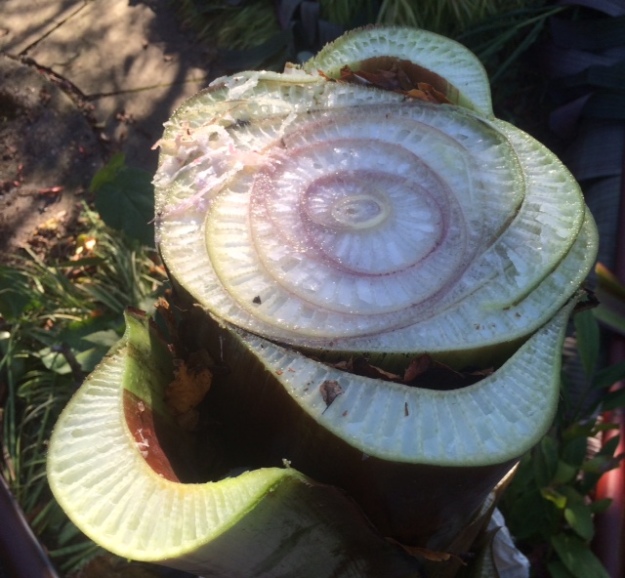
‘The Cut’ 10″ across, 4 1/2′ up the pseudostem. You can see how the outer leaves have been separated from the p-stem by wind. New leaves always appear at the center forcing the p-stem to widen, unlike woody plants that add girth to the outside in ‘rings’.
These are simple to dig. There is no broadly spreading root structure to protect as there is with ‘woody’ plants. There appears to be very little root structure given the size of the top growth. All of the roots originate from the aforementioned bud of meristematic tissue at the plant’s base.
The roots don’t branch. The structure looks something like an old fashioned mop with thick, white, fleshy roots. I am still amazed by this plant’s vigor when I look at its roots. The plant won’t be growing when it’s stored as in the cool dark, so there is no need to keep the soil around the roots. It just adds weight. I don’t pot it either.

Rolled on to the tarp. Half the tarp is not showing below the roots. I’ll fold this end up to cover the psedostem
Once free I lay it on a blue tarp, wrap it up as if it were a diaper and tie it in place. It is usually too heavy to carry through my garden, down the 7 stairs, around to the front and then into the basement, I’m guessing 200lbs+. I get it on a dolly, roll it to the stairs, skid it down a plank, get it back on the dolly and wheel it around through my street grade basement door, get it close and then stand it up where it will spend the winter. I stand it, because it never really stops growing.
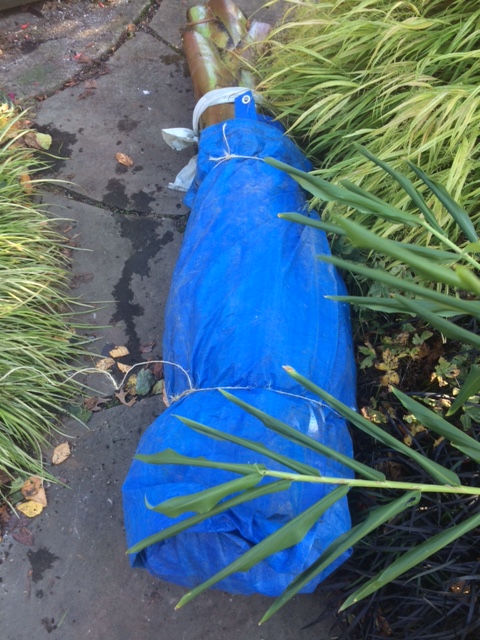
It’s too heavy for me to lift and poke twine underneath, so I hold an end of twine then roll the banana over until I can pull it through
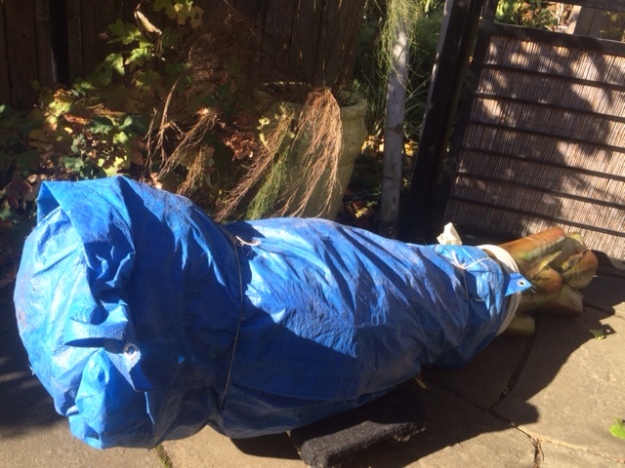
On the dolly and on the move. Get the dolly close then tilt it up lifting the top end, reposition the dolly near the base and then lower the banana. You’re now loaded on the dolly! Push or pull carefully so it doesn’t roll off. I have these big pieces of Blue Stone with small gaps that can catch wheels, pulling the root end works better for me.
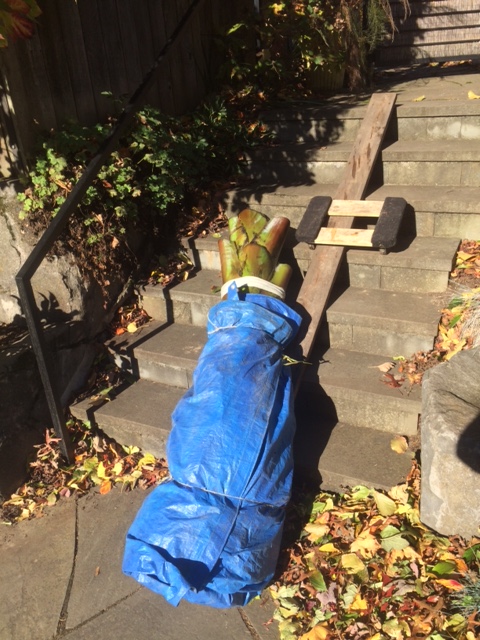
I have 7 stairs to get down. Position a 2×6 across the stairs. Roll the dolly off the top stair lip. The over hanging root end should settle on to the plank and slide down. Don’t try to hold it back, the top may swing to the side if you do. If it bounces on the stairs it crushes tissue.
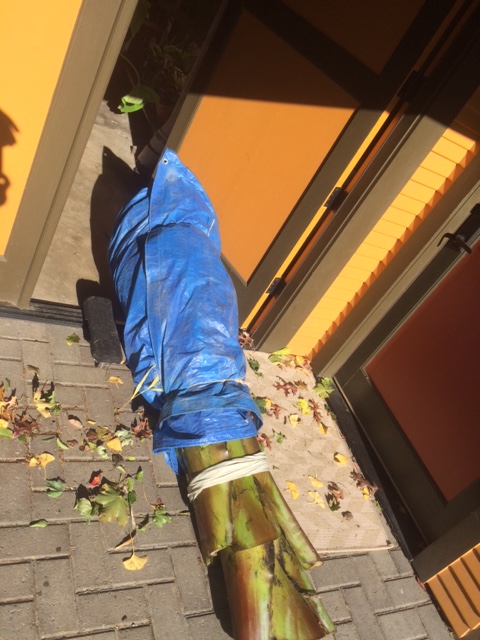
Get the dolly repositioned at the base of the stairs and roll to its destination. Going through the street grade basement door. Steering is accomplished by lifting the top end, most of the weight is on the dolly, and swinging it.
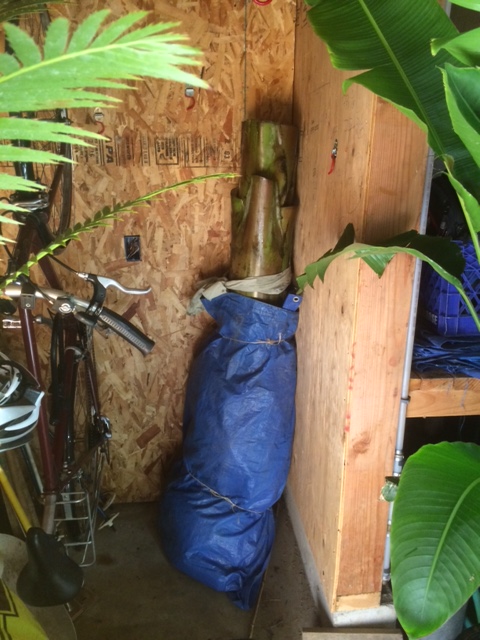
Here’s ‘baby’ tucked into her corner where nothing will bother her during her nap! Dioon poking in from the left, Heliconia on the right.
Ensete don’t have a freeze response. If its cold enough they just die, first the essential meristem. But, they do have a drought response. This storage technique is taking advantage of its drought response. A cool room will slow the metabolism rate down to the point where it won’t exhaust its reserves before it gets through the winter. When under drought stess an Ensete, unable to draw moisture from the surrounding soil, none in this case, will draw moisture and nutrients, from its outer most leaves back down to the bud to keep growing. Over time, in storage, the outer most growth will dry like raisins until its crisp while new leaves continue to slowly form and extend. 40º-45º is probably ideal. (Mine is too warm! Oh well!!) This will slow metabolism. There is no need to light the space and low light will encourage the formation of fragile, thin walled, etiolated, cells that will be shed when the plant is returned to the garden. You want to minimize the time in storage as this will lead to more tissue being metabolized and weakening the plant. Now you can see why damage done to the top growth before you bring it into storage will reduce the ‘reserves’ the plant has to use and result in a smaller weaker plant in the spring when it is planted out. A lot of people cut their bananas off low, just above the rhizome and meristem. I prefer to leave more of the p-stem in place for the reasons above.
When the weather has warmed and stabilized enough, after your last freezing lows, when highs are consistently above the mid 50’s and are supportive of active growth, you can bring it out. I cut the weak, etiolated, blanched growth off that has appeared over the winter. The plant will still be heavy. I’ve never weighed it going in or coming out, but I wouldn’t be surprised if it lost half of its water weight. Prepare the hole. I usually add and work in compost. Part of the process is to loosen the soil so the Ensete can ‘settle’ in to its spot. Don’t bother trying to fan out the roots or ‘build’ a center cone to stand the plant on. Whatever you do will be crushed by the weight of the plant. Don’t bury the crown or bud in an attempt ‘brace’ it. Set upright on ‘loose’ soil without any leaf blades to catch wind, the plant will tend to stay solidly in place. It will shed its old damaged roots and initiate new ones soon enough, re-anchoring the plant. I’ve never had one topple in a spring wind before. Over time cut away the dried husks of the old leaves, but be careful not to cut into of the healthy growth as that could compromise it. Fertilize and water as needed and you’re good to go for another cycle.

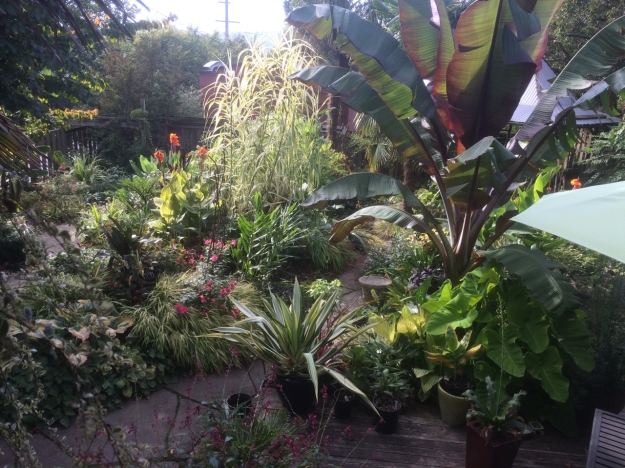
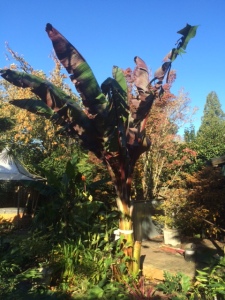
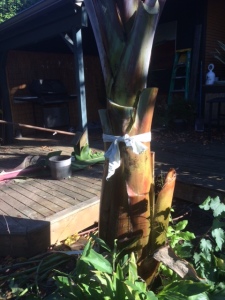
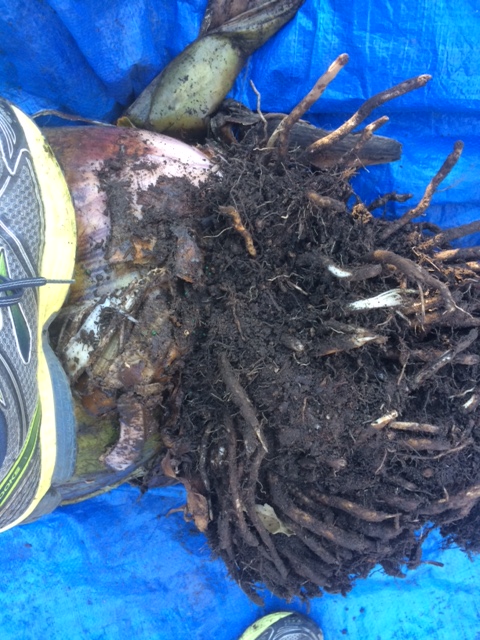
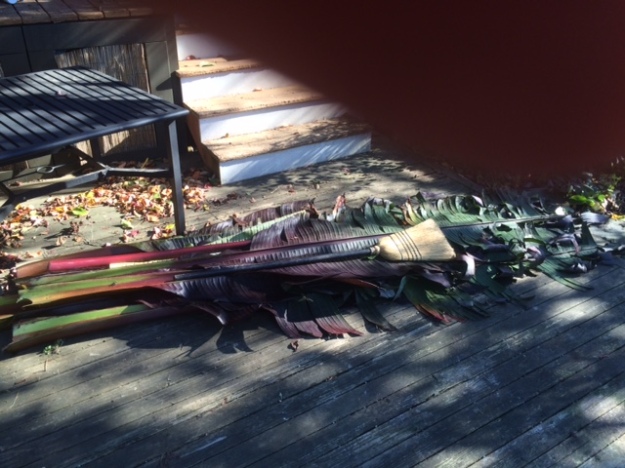
Lance, I super appreciate how well you’ve documented things over the years! It’s such an honor to get to take care of this Ensete. I did a few things differently than you did this year because it was raining around when I did the initial chop, so I didn’t cut down as far, tipped it upside-down in the corner of the covered area of the deck for a couple days to ensure there was no rain holding out in there, and then sliced off the crushed tissue at the top. I also put it in relatively dry soil in a pot in the basement, and covered it loosely with a large contractor trash bag to keep the lights I have down there now from messing with its “dormancy”. It is now the end of March and after a brief heat wave towards the end of February tricked it into trying to push out a leaf, I’m prepping to take it outside in a week or so in early April if highs are consistently over 50ºF. I may end up using a similar method with a Dicksonia antarctica that I got from Cistus!
LikeLike
When you say “cool” storage , what is that in degrees? I am in zone 7. Would shed storage be to cold? Temps can go down below freezing in January and February.
Tropical bananas metabolize down to 50F. Ideally store it between 50 and 40. Freezing Will do permanent damage or kill it.
LikeLike
Is it too soon to bring it out now? It suffered some damage in the first frost (snuck up on me!), so I dug it up and followed your instructions. It’s in the tool shed out back. We’re so close to Spring, I want to bring it out asap. I’m in Portland, too!
LikeLike
Mine, is staying in the basement for now. The forecasted lows are all below 40º with 3 nights in the next 10 predicted to be at or just above freezing. The long range forecast is for slightly cooler and wetter than normal and it seems to be tracking that way. Even if it doesn’t freeze, its not going to do anything in terms of growth, its just still too cool for these to start growing. And exposing it to freezing lows isn’t going to help it any at all.
LikeLike
Hello! Oh my goodness, I thought I sufficiently researched how to “overwinter” my Red Abyssinian Banana (Ensete ventricosum ‘Maureli’). My husband did not want to dig it up and give it any special treatment, so we cut it down to the ground and covered it with mulch and “sheltered” it under an upside down pot. I removed the mulch about a month ago in late April and it smelled rotten, but after removing all of the stinky stuff there is a solid, healthy looking kind of “corn cob” base there. There is no indication a leaf will start/is starting, but as I said it’s not rotten to the core. There are no leaves left as we removed all of them. I’ve cried many tears over losing this dear plant and am wondering if there is any hope of it somehow coming back to life. My husband encouraged me to buy another one in June. It was expensive, and I’ve made peace with myself that I can buy another and think of it as a “bouquet” for the summer months to be enjoyed for one season. However, I just cannot bring myself to give up on the base of last year’s plant that brought so much happiness and wonder into my heart. Should I did it up and do something special with it to coax it back to life? Or should I dig it up and compost it? My heart is just broken because I feel like I killed such a beautiful and majestic living thing.
LikeLike
Hi there, I do realise that this is an old post but I thought Id give it a try anyway. I have a Musa Ensete in a pot that I have had for several months( UK indoor potted) and it was doing very well. I was trying to cut the dead leaves with a blade and I accidentally cut right through the stem ! dah :(( so I am now left with a 20cm stem above the compost. my question is that is the plant going to survive and grow new leaves or have I just killed it?! I would really appreciate some advice. thank you.
LikeLike
Hi,
All true Bananas are monocots. The meristematic tissue, the growing point where cell division is initiated, the growing point in other words, is part of and on top of the rhizome in the ground. The stem, the pseudo stem, is actually a tight roll of individual leaves. Each leaf that fans out from the top of the plant, originates from this meristem. If you cut this ‘pseudo stem’ off at any point, the meristem is still fine and will re-grow the lost leaves. It can slow the growth because the plant must replace the lost leaves, but the rhizome contains a lot of starches/energy. As long as you don’t do this repeatedly during the growing season, your banana should be fine. As I say in the blog posting, I cut my stem back to 4′ in the late fall to make it easier to move and store.
LikeLike
Dear ‘Garden Riots”—HELP!!!!!
I see you are in Portland, OR! So am I! This last summer I acquired an Ensete maurelli and it has thus far done quite well. I was warned to bring it in once the temperature dropped, and I moved it into a back room in my house where there is a plant light hanging from the ceiling. It seems that this plant is in love with its new surroundings and it is growing like mad, spitting out new, HUGE, healthy looking leaves every week. It is rapidly reaching the 7 foot ceiling of the room and will soon have nowhere to go. I am panicking a bit. I may just have the least green thumb of anyone I know and would be extremely fearful of doing what it is you describe above. Also, I don’t have any cool basement or dark space to keep a leafless stump for the winter. By any chance could I email you privately and set up a time to discuss this over the phone? I am desperate for help, since the place where I purchased this plant (Hughes Water Garden) really didn’t have any good suggestions for me. Please email me using the attached email if you can!
LikeLike
These bananas need daylight, water and temps over 50 to grow, 60+ is better. To store them you need to induce a dormant state. The best way to do that is to lower these 3 elements together without causing it to freeze. As I wrote, this will put the plant in a kind of drought dormancy which it can tolerate. Moving it into a warm interior room of you house will cause the plant to continue metabolizing at a relatively high rate. This will make it grow and utilize water at a higher rate. This is fine in a ventilated healthy greenhouse, not so much in a room in your house. Unless you have ‘designed’ your light system for growing, normal house lighting levels will be too low and yes it will grow but it will be etiolated, weak and more susceptible to damage. Time is important here as well. The longer it endures in a low light warm room the more damaged your plant will be. December, January, February and March is a long time to store it like this. Cool dark, because the metabolism is greatly slowed, does not weaken the plant in the same way. Dormancy is a kind of stasis period. If it must stay inside and you can’t provide good greenhouse conditions, do what you can. Cut the leaves off, you want to discourage growth. Put it in an auxiliary room. Turn down the heat as much as you can, below 60º, or block the heat ducts. Keep the room dark or create an opaque tent around it. Don’t fertilize, with-hold water and cross your fingers. With-holding water in a warm lit room will cause more severe desiccation. Again, time is a major factor in this. You are asking the plant to do something it may not be able to do.
LikeLike
Oh thank you so much for the information! Im very glad I haven’t killed it. phew :D
LikeLike
Great info!
Is it possible for me to use your photos explaining the procedure in a swedish blogarticle about overwintering bananas (on this site: http://www.odlabananer.se (in swedish though))?
LikeLike
I did the same method this year. I’ve never tried it before. I was surprised at how heavy the thing was. I need to remember to check back to see you success. Better yet I hope you post a link in the Oregon Gardeners Facebook page so I won’t miss it.
LikeLike
OMG – THANK YOU! It might be too late, but I will be sure to do this asap! Great post!
LikeLike
I’m sure I’ve asked you before, but just how old is your plant?
LikeLike
Loree, I’m guessing about 8 years. I think I’ve bought three in the last 15 years or so. The first one made it only three growing seasons dying in the second winter. I wintered the first one outside over a mild winter packed in stay and tarps. The same technique didn’t work the second winter. The wind had toppled it in the fall and it rotted out. I dug it the third winter and have ever since. The second banana grew weakly and I gave up on it after two summers.
LikeLike